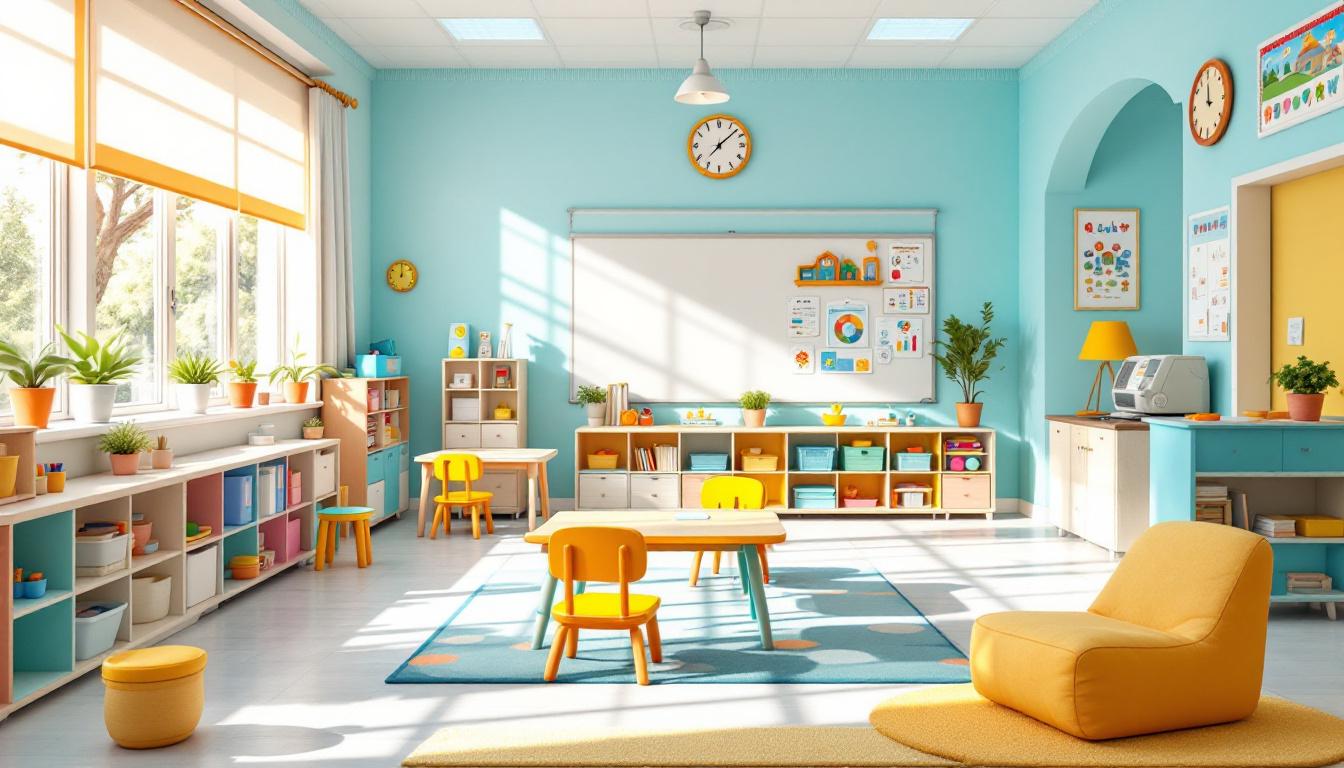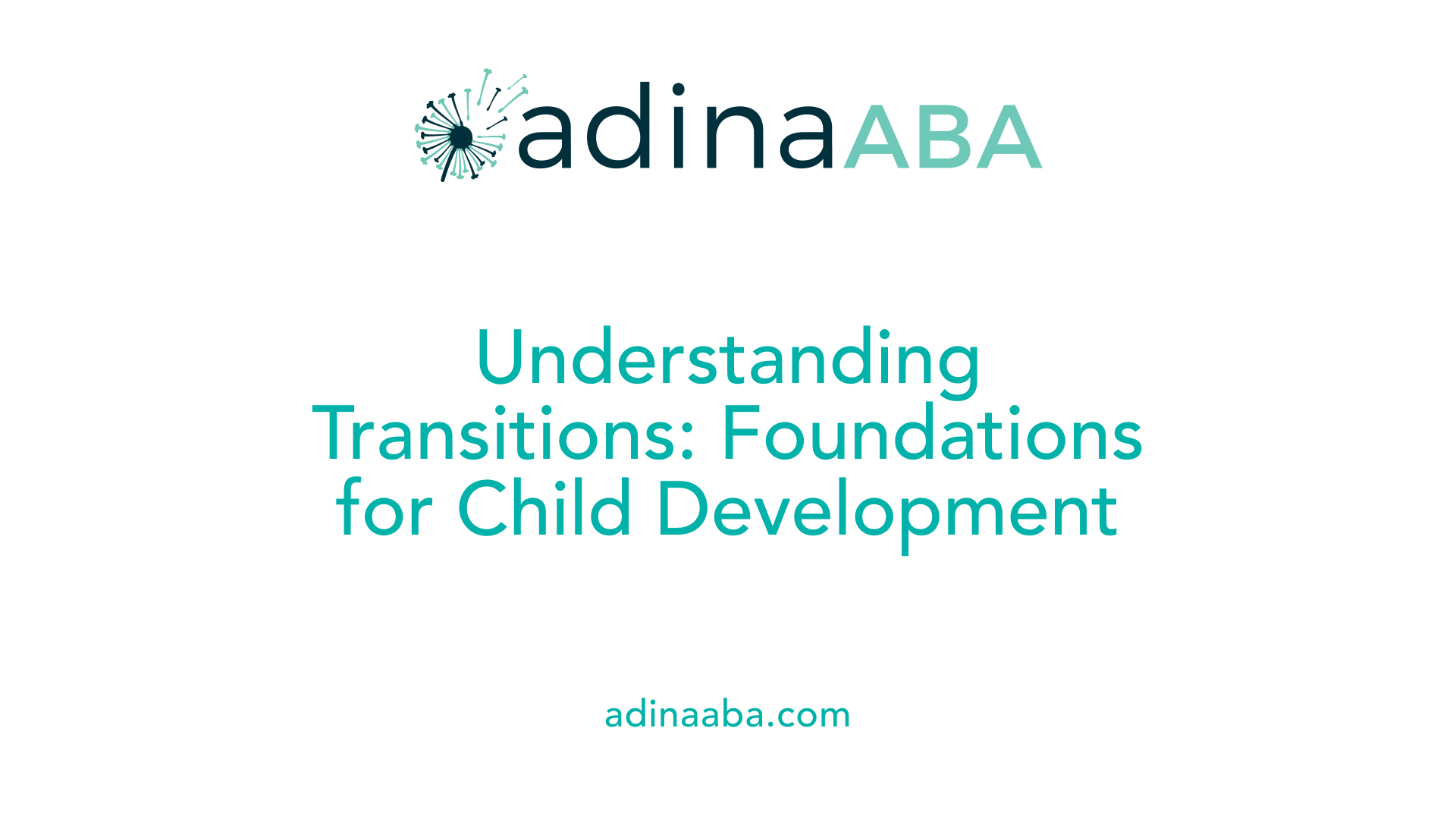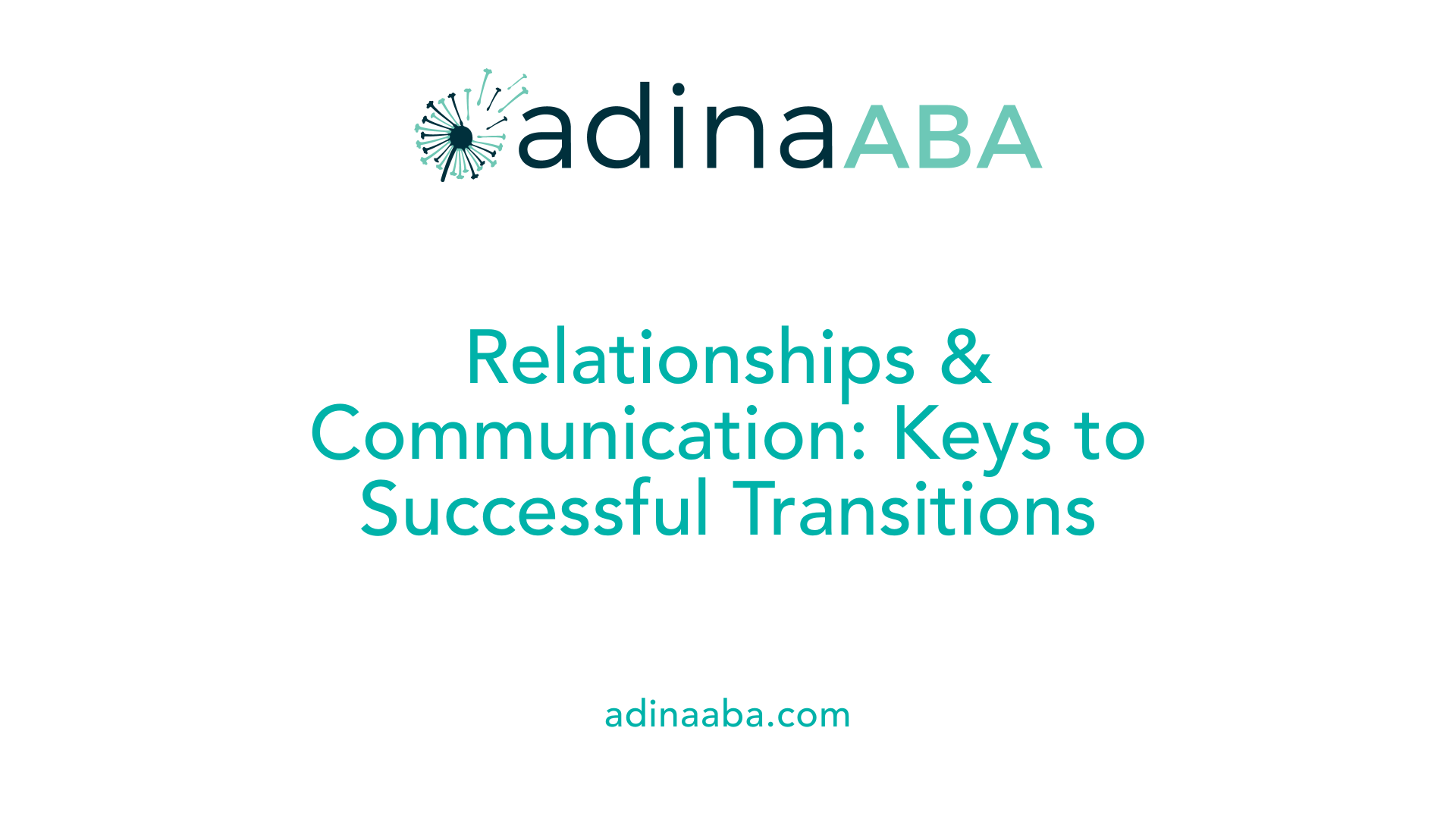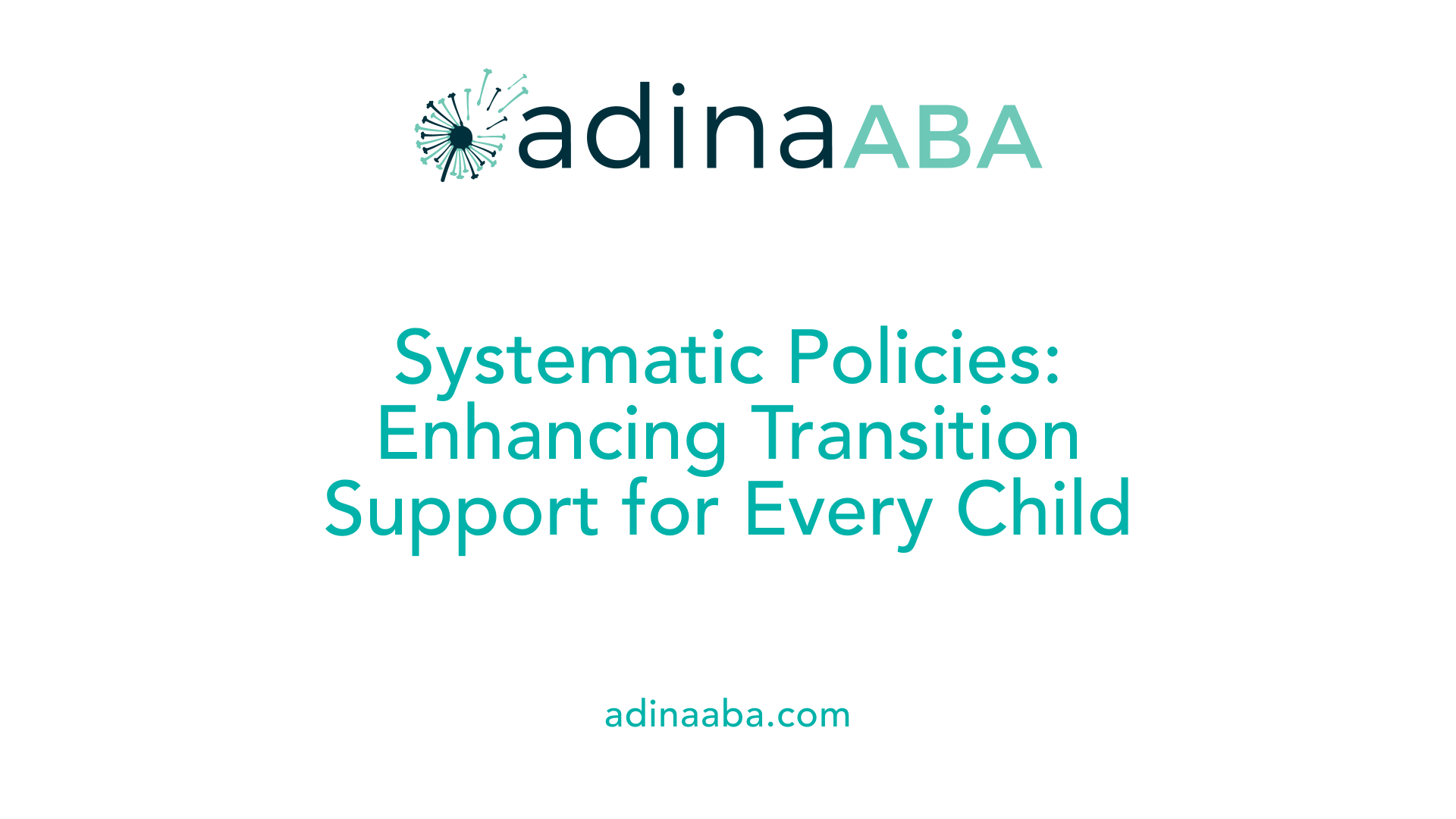Supporting transitions from one-on-one to group settings

Understanding the Crucial Role of Transitions in Early Childhood Development
Transitions in early childhood encompass the movement from one activity, setting, or social context to another and are fundamental to children’s daily routines and development. Managing these transitions effectively supports children’s emotional, social, and cognitive growth, reduces challenging behaviors, and fosters a sense of security and independence. This article explores evidence-based strategies and practices for supporting children as they move from one-on-one interactions to group settings, emphasizing tailored approaches for diverse needs and collaborative efforts among educators and families.
Fundamentals of Transition Support in Early Childhood

What is the importance of understanding what transitions are?
Transitions in early childhood refer to moments when children move from one activity or setting to another. These include routine changes such as arriving at a care setting, moving between activities, or bedtime routines. Transitions can involve physical shifts, changes in social groups, or shifts in tasks and expectations.
Understanding transitions is crucial because these moments significantly impact a child's emotional wellbeing, sense of security, and ability to adapt to new environments. When children navigate transitions successfully, they develop important self-regulation, communication, and social skills, all of which are foundational for lifelong learning and development.
Why are transitions developmentally significant for children aged Birth-8?
During the early years, children undergo rapid growth across physical, language, cognitive, social, and emotional domains. Transitions are integral to this developmental process because they provide opportunities for children to practice new skills, adapt to changing situations, and build resilience.
For children aged Birth-8, transitions facilitate the development of independence, decision-making capabilities, and emotional regulation. They help children learn routines, understand expectations, and develop a positive attitude towards change. Well-supported transitions foster a sense of competence and confidence, which are vital during these formative years.
How do abrupt changes in environment or routine impact children's well-being?
Abrupt or poorly managed transitions can have detrimental effects on children's well-being. Sudden changes may cause feelings of confusion, stress, or anxiety, especially for children with limited social skills, communication delays, disabilities, or previous adverse experiences.
Such abrupt shifts can lead to behaviors like tantrums, withdrawal, or aggression. They can also disrupt a child’s sense of predictability and safety, impeding their ability to focus, learn, and emotionally regulate. Over time, frequent or stressful transitions without adequate support may affect a child's self-esteem and their capacity to cope with future challenges.
Addressing these impacts involves implementing strategies that make transitions predictable, supportive, and tailored to individual needs. Systematic approaches can help children feel more secure, valued, and ready to engage in new activities or settings.
Supporting smooth transitions: practical strategies
Supporting children through transitions requires intentional planning and active engagement. Effective strategies include:
- Planning ahead: Preparing children by discussing upcoming changes, using visual schedules, or engaging in anticipatory activities.
- Visual cues: Charts, picture schedules, and sign language can help children understand what is next.
- Using auditory cues: Transition songs, countdowns, or timers help signal imminent change.
- Turning activities into routines or games: Making transitions engaging reduces resistance and anxiety.
- Providing emotional support: Reassurance, comfort objects, and talking about feelings promote emotional regulation.
- Gradual transitions: For children with heightened sensitivity, slowly shifting between activities with short, repeated steps can ease discomfort.
- Involving families: Sharing strategies and consistency between home and setting reinforce positive experiences.
How can educators and parents work together to build effective transition routines?
Collaboration between educators and parents is vital for establishing consistent and supportive transition routines. Teachers can share insights about each child's preferences and needs, while parents can provide information about routines and strategies that work at home.
Practicing shared routines, communicating regularly through tools like parent-teacher meetings or digital platforms, and creating joint plans help create continuity. Educators can involve parents through storytimes about transitions, home visits, or workshops focused on supporting children's emotional and behavioral regulation.
This partnership promotes a unified approach, which reinforces predictable and positive experiences during transitions.
Personalizing transition strategies for children with diverse needs
Children's needs vary widely, and some may require individualized approaches. For children with disabilities, language barriers, or sensory sensitivities, tailored strategies are necessary.
Effective adaptations include:
| Strategy | Description | Additional Support |
|---|---|---|
| Visual supports | Picture schedules, social stories | Use culturally relevant images, incorporate sign language |
| Sensory tools | Fidgets, weighted packs, calming objects | Support sensory regulation during transitions |
| Visual and auditory cues | Timelines, transition songs | Pre-warn children about upcoming changes |
| Involving families | Tailored routines at home | Consistent practices across environments |
| Slow-paced transitions | Extended time, gradual shifts | Especially for children with disabilities or anxiety |
Personalized approaches respect each child's unique developmental trajectory, cultural background, and preferences.
Building relationships: supporting families during transitions
Strong, trusting relationships with families are central to a child's successful transition. Practitioners can foster these by maintaining open communication, respecting diverse cultural practices, and involving families in the planning process.
Offering workshops about supporting transitions, regularly sharing progress, and encouraging family participation in routines strengthen mutual understanding. Respectful, empathetic interactions help parents feel valued and supported, reducing separation anxiety.
Shared rituals and meaningful conversations about routines help children feel secure, and involving families in creating transition tools—like visual aids—enhances consistency.
Integrating transitions into classroom management routines
Embedding transition activities into daily schedules involves establishing clear routines and predictable procedures. Consistent use of visual cues, timers, and signals helps children understand when a transition occurs.
Incorporating engaging activities such as transition songs, movement breaks, or simple games makes changeovers less disruptive. Assigning classroom roles or responsibilities during transitions fosters independence and cooperation.
Furthermore, regular review and adjustment of routines based on observation ensure that routines remain effective and responsive to children’s evolving needs.
Why understanding and supporting transitions matter?
Supporting smooth transitions benefits children's emotional health, behavior, and overall development. Well-designed transition policies reduce stress, minimize challenging behaviors, and promote positive attitudes towards change.
Creating systemic supports through policies, training, and collaboration ensures that transitions are seen as ongoing processes rather than one-time events. This perspective encourages continuous support, fostering resilience and readiness for future transitions.
By emphasizing relationships, routine, and individualized support, educators and families can work together to make transitions positive milestones in children’s developmental journeys.
Role of Relationships and Communication in Transition Success

How do building trusting relationships with children and families support successful transitions?
Establishing strong, trusting relationships is fundamental for guiding children smoothly through transitions. When caregivers and educators develop bonds characterized by warmth, consistency, and responsiveness, children feel more secure and confident when facing change. Trust acts as an emotional anchor that helps children navigate new environments with less anxiety.
These relationships also enhance communication, making it easier for adults to understand children's needs, fears, and preferences. For families, building connections with staff fosters a collaborative partnership, encouraging open dialogue about routines, developmental goals, and individual circumstances.
Children who experience stable, positive relationships are more likely to explore unfamiliar settings, express their feelings openly, and adapt to new routines. For example, if a child trusts their key person, they are more willing to participate in activities and transition between spaces calmly. This sense of security directly influences their confidence and resilience during change.
What are effective communication strategies, including visual supports and verbal cues?
Effective communication during transitions combines verbal instructions with visual tools to enhance clarity and understanding. Visual supports like picture schedules, Now and Next boards, and visual cues serve as helpful prompts, especially for children with developmental or sensory challenges. These tools prepare children for upcoming changes, reduce uncertainty, and foster independence.
For example, a visual timetable showing pictures of activities helps children anticipate what comes next and feel more in control. Verbal cues such as simple, clear instructions reinforce visual prompts and ensure children understand expectations.
Turning transition times into engaging routines—such as singing transition songs, using countdowns, or incorporating movement activities—also captures children's attention and makes change feel predictable. Repetition and consistent cues create familiarity, which boosts children's comfort and cooperation.
Why is caregiver consistency and emotional availability important?
Caregiver consistency builds trust and provides a sense of stability that children rely on during busy or stressful times. When children experience stable relationships with familiar adults who are emotionally available, they feel safer and more willing to face new challenges.
Being emotionally available means caregivers respond promptly and empathetically to children's cues, offering reassurance and understanding. This availability helps children regulate their feelings and manage anxiety associated with transitions.
Consistent routines and interactions reinforce positive expectations, making transitions smoother. For example, if a caregiver consistently greets children warmly or offers a calming activity before a transition, children learn that their feelings matter and that support is available.
How do practices support families and build relationships during the transition process?
Supporting families involves open, respectful, and culturally sensitive communication. Sharing information about routines, routines, and developmental expectations helps families understand and prepare their children for change.
Involving families in planning, such as inviting them to visit new environments or participate in transition activities, fosters trust and collaboration. Regular updates through newsletters, digital apps like ParentZone, and personal conversations ensure families are informed and engaged.
Creating opportunities for families to share their strengths, routines, and concerns further enhances the partnership. This reciprocal communication helps tailor transition strategies to meet each child's unique needs.
Involving families in the development of individualized transition plans, and respecting their cultural practices, reinforces a sense of partnership and shared goal setting. Such practices create a supportive environment where children feel secure, valued, and ready for the next phase.
How does cultural sensitivity and inclusivity contribute to positive transition experiences?
Cultural awareness and inclusivity play crucial roles in ensuring that all children experience respectful and welcoming transitions. Recognizing diverse cultural backgrounds involves understanding different routines, languages, and traditions.
Incorporating culturally relevant materials, bilingual resources like Polylino, and involving families in the planning process helps children feel seen and respected. For example, using familiar songs, stories, or customs from a child's culture can ease stress and create a sense of continuity.
An inclusive environment actively celebrates diversity, promoting a positive self-image and belonging. This approach also builds trust with families, ensuring they feel comfortable engaging with educators and participating fully.
Tailoring communication and routines to cultural contexts allows children to transition with confidence, knowing their identities are valued. Ultimately, this support fosters resilience and positive attitudes toward new experiences.
Supporting the Transition Environment and Classroom Routines

How can transitions be integrated into classroom management to facilitate smoother day-to-day routines?
Transitions are an integral part of classroom management, helping children move seamlessly from one activity to another. To achieve this, teachers should establish clear routines that are explicitly taught and reinforced regularly. Explaining procedures, modeling behaviors, rehearsing transitions, and reviewing them help children understand expectations.
Visual cues such as timers, countdowns, chimes, or traffic lights play a vital role in signaling upcoming changes. These tools prepare children mentally and emotionally, reducing confusion and disruptions. Making transitions engaging through songs, movement activities, or classroom jobs not only captures children’s interest but also fosters a sense of responsibility.
Providing precorrectives—anticipatory guidance—and using visual supports and positive reinforcement encourage children to self-regulate and participate cooperatively. When children have specific roles or are involved in signaling transitions, they develop independence and confidence. These strategies create a predictable and structured environment that promotes smooth daily routines.
What types of visual supports and cues are effective during transitions?
Visual supports are essential for helping children understand and anticipate transitions. Common tools include picture schedules, Now and Next boards, visual timers, and social stories that depict each step of an activity in a simple, visual format.
Picture schedules outline the day’s sequence, giving children clarity about what comes next, which minimizes anxiety. Now and Next boards prepare children for immediate upcoming activities, creating a routine of predictability.
Timers and countdowns—visual or auditory—signal when a transition will occur and help children pace themselves. Social stories, especially useful for children with Autism Spectrum Conditions or developmental delays, describe what will happen and why, easing fear of change.
Signage with clear images and color-coding further reinforces spoken instructions, especially when combined with tactile cues for children with sensory needs. Consistent use of these supports fosters independence, reduces confusion, and helps children navigate transitions more easily.
What role do environmental arrangements play in supporting transitions?
The physical environment significantly influences how smoothly children transition between activities. Well-organized spaces with designated zones—such as activity areas, quiet corners, and transition points—help children recognize where to go and what is expected.
Using visual boundaries like rugs, furniture arrangements, or visual partitions creates clear visual cues for movement and activity separation. These visual demarcations help children understand which area they are in and what behavior is appropriate.
Environmental supports also include providing accessible materials and calming zones with visual anchors like posters or visual schedules. This setup encourages children to move independently and minimizes overstimulation and confusion.
Designing space for easy movement and minimizing wait times facilitate ongoing activity flow. When children can navigate familiar, thoughtfully arranged environments, they experience fewer disruptions, are more engaged, and handle transitions with greater ease.
How does involving children in transition preparation enhance their sense of control and independence?
Involving children actively in transition preparation deepens their sense of control and fosters independence. Giving children choices—for example, selecting their transition objects, the order of activities, or their preferred transition songs—empowers them.
Using visual planning tools such as picture schedules or countdown timers allows children to anticipate and prepare for upcoming changes, reducing anxiety.
Engaging children in these preparations increases their motivation and cooperation. When they are part of the process, they learn to recognize cues and internalize routines, which promotes self-regulation.
This approach nurtures confidence as children gain skills in managing their emotions and behaviors during change. Ultimately, involving children in transition planning creates a positive environment where routines are smoother, and children feel competent and autonomous.
Visual Support Examples and Implementation Tips
| Tool | Description | Implementation Tips | Benefits |
|---|---|---|---|
| Picture Schedules | Visual sequence of daily activities | Use real photos or drawings; review daily; place them in accessible spots | Reduces uncertainty; enhances independence |
| Now and Next Boards | Highlights immediate upcoming activity | Update regularly; involve children in choosing what appears next | Builds anticipation; improves understanding |
| Visual Timers | Indicate time remaining visually | Use with countdown signals; connect to routines | Fosters patience; improves time awareness |
| Social Stories | Short narratives about routines | Create tailored stories; read before transitions | Eases anxiety; clarifies what to expect |
| Signage and Symbols | Visual cues for specific behaviors or steps | Use consistent images/simple signs; reinforce through practice | Supports communication; reduces misbehavior |
Environmental Arrangement Strategies
- Use visual boundaries to divide areas
- Arrange furniture to facilitate movement
- Create calming zones with visual anchors
- Ensure materials are accessible at children's eye level
- Incorporate visual schedules and cues into the environment
Adopting these approaches results in a more predictable, calm, and responsive routine, helping children navigate transitions successfully, fostering confidence, and reducing behavioral challenges.
Policy and Practice for Systematic Transition Support

Why is understanding the significance of transitions important, and how can policies and frameworks facilitate them?
Transitions are pivotal moments in a child's development, involving shifts from one activity, setting, or stage of learning to another. They encompass everyday routines like moving from home to childcare, switching between activities, or transitioning into formal schooling. Recognizing the importance of these moments is crucial because they influence a child's emotional security, confidence, and ability to adapt.
When children experience well-supported transitions, they are less likely to encounter stress and challenging behaviors. Effective understanding and management of transitions help foster a sense of stability, control, and positive self-identity.
Policies and frameworks play a vital role in guiding consistent, predictable, and responsive practices. They facilitate the development of structured routines such as visual schedules, countdowns, and engaging transition activities that prepare children emotionally and cognitively for change.
Collaborative approaches involving educators, families, and service providers ensure continuity across different settings and stages of education. These systems promote sharing relevant information, aligning expectations, and customizing support to meet individual needs, including those of children with disabilities or additional support requirements.
By establishing clear procedures and fostering partnerships, policies reduce uncertainties related to transitions and enable proactive planning. Such frameworks also encourage ongoing training and reflection among practitioners, which enhances their capacity to support transitions effectively.
In summary, understanding the importance of transitions and embedding this awareness into systemic policies contributes substantially to children's emotional well-being and lifelong learning success, providing them with the confidence and resilience needed for future challenges.
Building a Cohesive Approach to Transition Support
Supporting children through transitions from one-on-one to group settings demands a comprehensive, relationship-centered approach that combines evidenced-based strategies, inclusive practices, and collaborative partnership with families. Recognizing the importance of routine, communication, and environment, practitioners can implement structured routines, visual supports, and sensory tools tailored to diverse needs. Ongoing reflection, policy development, and staff training are essential to refine practices and ensure consistency. Ultimately, fostering strong relationships, promoting emotional regulation, and embracing a proactive, adaptable mindset will enable educators and families to create seamless transition experiences that support children’s confidence, resilience, and lifelong learning success.
References
- Reducing Challenging Behaviors during Transitions: Strategies for ...
- Strategies That Help Students Manage Transitions - Edutopia
- [PDF] Understanding and Supporting Transitions in Early Childhood ...
- Supporting Transitions within Nursery Settings - Connect Childcare
- How Can We Help Kids With Transitions? - Child Mind Institute
- Supporting Early Childhood Transitions | Texas SPED Support
- Transitions for Children - The OT Toolbox
- Relationship-building During Transitions | HeadStart.gov
More Resources
Expert Clinicians
Get started today ->




.jpg)
.jpg)
